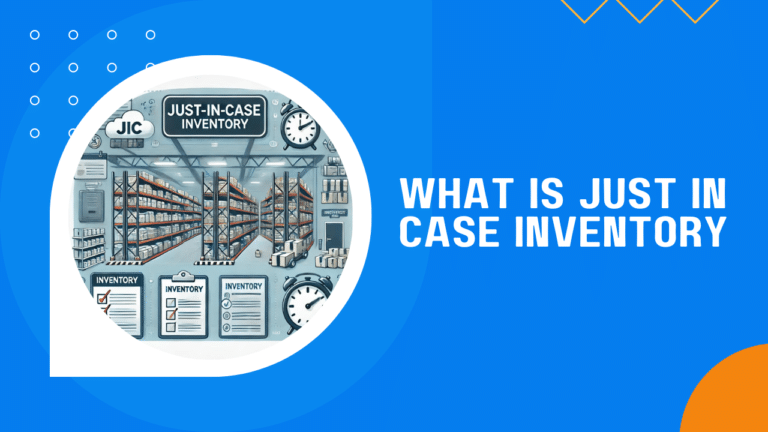Inventory management plays a crucial role in ensuring the smooth operation of any business, directly impacting profitability and customer satisfaction. In today’s unpredictable global market, where supply chain disruptions and demand fluctuations are increasingly common, traditional inventory strategies are being re-evaluated.
One such strategy gaining renewed attention is just in case (JIC) inventory. This approach involves maintaining higher stock levels as a safeguard against uncertainties, providing a buffer that can keep businesses running even when supply chains falter.
As companies strive to find the right balance between risk management and cost efficiency, understanding the principles and benefits of JIC inventory is more important than ever.
What is Just in Case Inventory?
Just in case (JIC) inventory is a strategy where businesses maintain extra stock to protect against potential disruptions in the supply chain, unexpected surges in demand, or other unforeseen events.
Unlike just in time (JIT) inventory, which focuses on minimizing stock levels to reduce holding costs, JIC is about ensuring that there is always sufficient inventory available to meet customer needs, even in the face of uncertainties.
Historically, JIC was the dominant approach before the rise of lean manufacturing and JIT methodologies. It was widely adopted in industries where the cost of running out of stock far outweighed the costs associated with holding extra inventory.
Although JIT has become more popular due to its efficiency, the global disruptions experienced in recent years have led many companies to reconsider JIC as a viable strategy for enhancing supply chain resilience.
How Does Just in Case Inventory Work?
Just in case (JIC) inventory operates on the principle of maintaining a safety stock that exceeds the immediate demand to safeguard against potential disruptions. This involves regularly reordering inventory well before it reaches critical levels, ensuring that there is always a buffer in place.
JIC is particularly useful in industries characterized by unpredictable demand or where supply chain interruptions are common. For example, companies in sectors such as healthcare, where stock outs could have serious consequences, often rely on JIC to ensure they can meet sudden spikes in demand. Additionally, businesses that source materials from regions prone to geopolitical instability or natural disasters may also adopt JIC to avoid production halts.
Key Principles of JIC Inventory Management
- Safety Stock Maintenance: At the heart of JIC inventory management is the maintenance of safety stock—a reserve of extra inventory kept on hand to cover unexpected spikes in demand or delays in supply. Unlike the lean, minimal approach of just in time, where inventory is kept as low as possible, JIC ensures that a surplus is always available. This surplus acts as a buffer, allowing businesses to continue fulfilling orders even when regular supply chains are compromised.
- Preemptive Reordering: Businesses utilizing JIC inventory often engage in preemptive reordering—restocking inventory before it reaches a critical low level. This proactive approach reduces the risk of running out of stock and ensures that production lines remain operational, even in the event of supply chain delays. Reordering schedules are typically based on historical data, forecasted demand, and the lead times required for replenishment. You can utilize our free safety stock calculator to help you plan.
- Inventory Buffering: JIC relies heavily on inventory buffering—the practice of keeping additional stock to manage variations in supply and demand. This buffering is crucial in industries where demand is highly variable or where supply disruptions are common. For instance, companies in the automotive industry may hold extra stock of critical components to avoid production delays caused by late deliveries from suppliers.
By prioritizing the availability of products, JIC enables businesses to fulfill customer orders consistently, even during supply chain challenges, thereby maintaining operational continuity and customer satisfaction.
Advantages of Just in Case Inventory
Just in case (JIC) inventory provides several significant advantages that can make it an essential strategy for businesses operating in volatile markets or industries where supply chain disruptions are common. These advantages revolve around enhancing operational resilience, ensuring customer satisfaction, and maintaining a competitive edge.
1. Supply Chain Resilience
One of the primary benefits of JIC inventory is its ability to strengthen a business’s supply chain resilience. By keeping extra stock on hand, companies can avoid stock outs—a situation where demand outstrips supply—during periods of supply chain disruption or unexpected demand spikes. This resilience is particularly crucial in industries where supply chains are complex and global, such as electronics or automotive manufacturing, where delays or interruptions can halt production lines and lead to significant financial losses.
For instance, during the COVID-19 pandemic, companies that had implemented JIC strategies were better equipped to handle supply chain shocks and meet customer demands, even as global logistics networks faced unprecedented strain. By having a buffer of inventory, these businesses could continue operations without the severe disruptions experienced by those relying solely on just in time inventory methods.
2. Customer Satisfaction
JIC inventory management plays a crucial role in ensuring customer satisfaction by guaranteeing that products are available when customers need them. In industries like retail or e-commerce, where consumer expectations for quick delivery are high, the ability to fulfill orders promptly can significantly enhance customer loyalty and satisfaction.
With JIC, businesses can meet sudden surges in demand without delays, ensuring that their customers do not turn to competitors due to out-of-stock products. This is particularly important during peak seasons, such as the holiday shopping period, where demand can skyrocket unexpectedly. Companies with a robust JIC inventory strategy are more likely to retain their customers and enjoy repeat business because they can consistently meet customer expectations.
3. Competitive Edge
Maintaining a competitive edge in today’s market often requires businesses to be prepared for the unexpected. JIC inventory allows companies to seize opportunities that others might miss due to stock outs. For example, if a competitor runs out of a popular product, a company with JIC inventory can step in and capture that market share, fulfilling orders that the competitor cannot.
This readiness to meet demand not only helps in gaining new customers but also builds a reputation for reliability and dependability. In industries where customer trust is paramount—such as healthcare, where consistent availability of critical supplies can be a matter of life and death—JIC can be a decisive factor in establishing and maintaining a strong market position.
In summary, while JIC inventory may involve higher upfront costs due to the need for additional storage and the risk of inventory obsolescence, the benefits in terms of supply chain resilience, customer satisfaction, and competitive advantage often outweigh these costs, making it a vital strategy for many businesses.
Disadvantages of Just in Case Inventory
While just in case inventory offers significant benefits, it also comes with several drawbacks that businesses must carefully consider. The primary disadvantages revolve around increased costs, the risk of inventory becoming obsolete, and the impact on cash flow.
1. Higher Holding Costs
One of the most significant downsides of JIC inventory is the higher holding costs associated with storing large amounts of inventory. These costs include expenses for warehousing, insurance, and maintenance of stock, as well as the costs associated with managing and protecting inventory against theft, damage, or degradation.
Warehousing costs, in particular, can escalate quickly as more space is required to store the extra stock. Additionally, the longer inventory remains in storage, the greater the likelihood of incurring costs related to its preservation, especially for perishable goods or items with a limited shelf life. Over time, these holding costs can significantly impact a company’s bottom line, particularly in industries with thin profit margins.
2. Risk of Obsolescence
Another critical disadvantage of JIC inventory is the risk of obsolescence. When businesses hold large quantities of stock, they face the possibility that the items may become outdated or unsellable before they are used or sold. This is particularly a concern in industries where products have short life cycles, such as technology or fashion.
For example, in the electronics industry, where technological advancements occur rapidly, products can become obsolete within months. If a company holds too much inventory, it may find itself unable to sell outdated stock, leading to markdowns, write-offs, or even disposal costs. This not only results in financial losses but also ties up valuable warehouse space that could have been used for more current, in-demand products.
3. Cash Flow Impact
The practice of maintaining a high level of inventory under JIC can also have a negative impact on a company’s cash flow. Tying up capital in excess inventory means that less cash is available for other critical business operations, such as investing in new technologies, expanding product lines, or marketing.
This reduction in financial flexibility can be particularly challenging for small and medium-sized enterprises (SMEs) that may not have the same access to credit as larger corporations. The capital invested in maintaining large inventory levels under JIC could otherwise be used for growth initiatives or to navigate economic downturns more effectively. In some cases, the cash flow constraints imposed by JIC inventory can hinder a company’s ability to respond quickly to market changes or seize new opportunities.
While just in case inventory provides a buffer against supply chain disruptions and demand variability, the associated higher holding costs, risk of obsolescence, and cash flow challenges make it a strategy that requires careful planning and consideration. Businesses must weigh these disadvantages against the potential benefits to determine whether JIC is the right approach for their specific needs and circumstances.
Just in Case vs. Just in Time: Choosing the Right Strategy
When it comes to inventory management, businesses often find themselves choosing between just in case (JIC) and just in time (JIT) strategies, each offering distinct advantages and trade-offs. The decision between these two approaches depends largely on a company’s specific needs, industry dynamics, and risk tolerance.
1. Understanding the Differences
Just in case involves maintaining a higher level of inventory to safeguard against potential supply chain disruptions, unexpected demand spikes, or other uncertainties. The focus is on being prepared for any eventuality, which can prevent stockouts but comes at the cost of higher inventory holding expenses and the risks associated with obsolete stock.
In contrast, just in time focuses on reducing inventory levels to the absolute minimum, with stock arriving only as needed for production or sales. This approach minimizes holding costs and reduces waste but requires a highly reliable supply chain to ensure that materials and products arrive exactly when required.
2. When to Use Just in Case
JIC is particularly advantageous in industries where supply chain reliability is uncertain or where the cost of running out of stock is exceptionally high. For example, industries such as healthcare, aerospace, and food production often rely on JIC to ensure that critical supplies are always available, even in the face of disruptions.
Additionally, businesses that operate in markets with high demand variability, such as fashion retail or consumer electronics, may prefer JIC to avoid losing sales due to stock outs during peak demand periods. For these companies, the ability to consistently meet customer needs outweighs the higher costs associated with holding extra inventory.
3. When to Use Just in Time
On the other hand, JIT is ideal for industries where supply chains are stable and predictable. Manufacturing sectors like automotive production often benefit from JIT because it allows companies to minimize inventory costs while ensuring that materials are available precisely when needed for production. This strategy is also effective in reducing waste, particularly in industries where products have a short shelf life or are subject to rapid technological changes.
JIT is also well-suited for businesses that prioritize cost efficiency and have established strong relationships with reliable suppliers. For companies with the infrastructure to support it, JIT can lead to significant cost savings and a more streamlined, agile operation.
4. Considering a Hybrid Approach
In some cases, a hybrid approach that combines elements of both JIC and JIT may be the most effective strategy. This approach allows businesses to maintain a baseline level of inventory to protect against disruptions (JIC) while still leveraging the cost efficiencies of JIT for regular operations. For example, a company might keep a small safety stock of critical components (JIC) while managing the bulk of its inventory on a JIT basis.
This hybrid strategy is particularly beneficial in industries with seasonal demand or where certain components are at higher risk of supply chain disruptions. By balancing the two approaches, businesses can optimize their inventory management to both reduce costs and ensure resilience.
Balancing Risk and Efficiency in Inventory Management
Choosing the right inventory strategy is essential for maintaining smooth operations and minimizing risks. just in case provides a buffer against supply chain disruptions and unexpected demand, but it comes with higher costs and the risk of holding outdated stock. just in time, on the other hand, focuses on keeping inventory levels low to reduce costs, but it relies heavily on a reliable supply chain.
The best approach depends on your specific business needs and industry challenges. Many companies find a hybrid strategy that combines both JIC and JIT elements offers the best balance between security and efficiency.
As you evaluate your inventory management, consider the risks and needs of your industry. Whether you prioritize the safety of JIC or the cost savings of JIT, the goal is to stay flexible and ready to adjust your strategy as conditions change. This way, you can ensure your business remains resilient and prepared for future growth.









